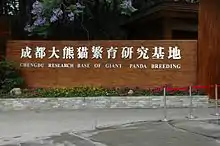 | |
| Other name | 成都大熊猫繁育研究基地 |
|---|---|
| Parent institution | Chengdu Municipal Park-City Construction and Management Bureau[1] |
| Founder(s) | Chengdu Municipal People's Government |
| Established | 1987[2] |
| Mission | Protect and breed giant pandas, red pandas and other endangered wild animals endemic to China |
| Website | panda.org.cn |
The Chengdu Research Base of Giant Panda Breeding (or simply Chengdu Panda Base) is a public non-profit breeding and research institute for giant pandas, red pandas, and other rare animals, located in Chengdu, Sichuan, China.[3]




Chengdu Panda Base was founded in 1987 by the Chengdu Municipal People's Government. It started with 6 giant pandas that were rescued from the wild. By 2008, it had 124 panda births, and the captive panda population has grown to 83.[4][5]
Its stated goal is to "be a world-class research facility, conservation education center, and international educational tourism destination."[4]
Partnerships
Chengdu Panda Base has partnered with many organizations in improving ways to conserve giant pandas. For example, its partnership with Zoo Atlanta helped the zoo secure the loan of 2 giant pandas.[6] To date, these 2 giant pandas, Yang Yang and Lun Lun, have produced five off-spring: Mei Lan in 2006, Xi Lan in 2008, Po on November 3, 2010, twins Mei Lun and Mei Huan on July 15, 2013[7][8][9][10] and twins Ya Lun and Xi Lun on September 3, 2016.
Other research partners include:[11]
- Adventure World in Shirahama, Wakayama, Japan
- East Bay Zoological Society, Oakland, California, United States
- University of Liverpool, England, UK
- National Institute of Health/National Cancer Institution, United States
- National Zoological Park, Washington, D.C., United States
- Nihon University, Tokyo, Japan
- North of England Zoological Society, England, UK
- The Oakland China Wildlife Preservation Foundation, California, United States
- San Diego Zoo, California, United States
- University of Japan
- Edinburgh Zoo, Scotland, UK
- Calgary Zoo, Calgary, Alberta, Canada
- Zoo/Tierpark Berlin, Germany[12][13]
On April 11, 2013, Chengdu Research Base of Giant Panda Breeding and CNTV reached an agreement on the establishment of iPanda.com after an official signing ceremony, and they immediately started preparing for the test launch (which was estimated in June, 2013).[14]
See also
References
- ↑ "组织机构 – 成都大熊猫繁育研究基地". 成都大熊猫繁育研究基地. Retrieved 2023-03-06.
- ↑ "成都大熊猫保护历史". 熊猫谷—成都大熊猫繁育研究基地都江堰繁育野放研究中心. Retrieved 2023-03-06.
- ↑ "About Panda Base - Chengdu Research Base of Giant Panda Breeding". www.panda.org.cn. Archived from the original on 2023-04-09. Retrieved 2023-03-06.
- 1 2 "About Chengdu Panda Base". Archived from the original on 2023-04-09. Retrieved 2014-09-26.
- ↑ "Giant Panda Base – Chengdu". My »Travel in China« Site. Archived from the original on 21 March 2019. Retrieved 21 March 2019.
- ↑ "Zoo Atlanta's Conservation Education Initiative in China". Archived from the original on 2008-03-17.
- ↑ "New Giant Panda cub born at Zoo Atlanta". Zoo Atlanta. Archived from the original on 2013-10-08. Retrieved 2008-09-15.
- ↑ "Zoo Atlanta's Giant Panda Cub Is Named Xi Lan". Zoo Atlanta. December 8, 2008.
- ↑ "2010's only US giant panda cub born in Atlanta zoo". CNN. 2010-11-03.
- ↑ "Zoo Atlanta and Dreamworks Animation Announce Panda Cub's New Name". Zoo Atlanta. February 15, 2011. Archived from the original on 2013-05-21. Retrieved 2011-03-28.
- ↑ "Research partners".
- ↑ "Geschäftsbericht 2017" (PDF). Zoologischer Garten Berlin AG. Archived from the original (PDF) on 27 March 2019.
- ↑ "Giant panda". Zoologischer Garten Berlin AG. 25 May 2023. Retrieved 25 May 2023.
- ↑ "央视网络 "熊猫频道"合作签字仪式在北京举行 - 成都大熊猫繁育研究基地". www.panda.org.cn. Retrieved 2016-10-15.